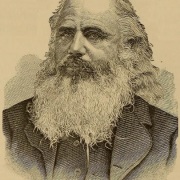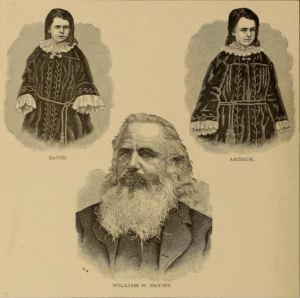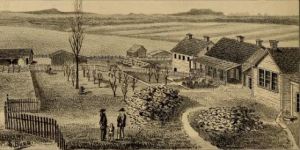Welcome to the William Davies & The Walla Walla Jesus History Website
Sketch of William W. Davies
William W. Davies (1833– 1906) was the leader of a Latter Day Saint schismatic group called the Kingdom of Heaven located in the foothills of the Blue Mountains overlooking Walla Walla from 1867 to 1881.
Davies was born in Wales to a Methodist family. In 1847, he converted to Mormonism and in 1854–55 he emigrated to Utah Territory as a Mormon pioneer to join the gathering of the members of The Church of Jesus Christ of Latter-day Saints.
After the Mountain Meadows massacre of 1857, Davies became disillusioned with the leadership of the LDS Church and became a follower of the schismatic leader Joseph Morris who was challenging the authority of Mormon leader Brigham Young.
Following the 1862 Morrisite War in which Morris was killed by authorities, Davies moved with a number of Morrisites to Deer Lodge County, Montana. While in Montana, Davies told of a series of revelations which instructed him to establish the “Kingdom of Heaven on Earth” near Walla Walla.
Davies and forty of his followers moved here in 1866 and eventually established a communal society on 400 acres near the top of Scenic Loop Road at its intersection with the road now known as Mormon Grade. Davies held legal title to all property in the Kingdom of Heaven.
Sketches of William Davies & his two children from “Historic Sketches of Walla Walla County,” F. Gilbert, 1882.
Davies taught his followers that he was the archangel Michael, who had previously lived lives as the biblical Adam, Abraham, and David. When his son Arthur was born on February 11, 1868, Davies declared that the infant was the reincarnated Jesus Christ, and the child came to be called “the Walla Walla Jesus.”
After the announcement, the size of Davies’ followers doubled; most of the new converts came from San Francisco, California and Portland, Oregon. When Davies’ son, David, was born in 1869, he declared him to be God the Father, and it is said that he also declared himself to be the Holy Spirit, completing the divine Trinity.
Although Davies claimed the power to raise the dead, the Kingdom of Heaven began to collapse in 1879 when Davies’ wife Sarah died of diphtheria, and in 1880, when both Arthur and David, members of the Trinity, died of the same disease.
Some of Davies’ followers then sued him in Walla Walla County Superior Court for the return of property given to the community, and for fair compensation for their donated work, and won a judgment. As a result, the land on which the community was located was sold at public auction by order of the court, which essentially brought the Kingdom to a close, though some never lost faith.
At the time of its break-up, there were 43 members of the Davies group. Davies then moved to a camp he owned on Mill Creek, where he briefly attempted to revive his following, but eventually gave up and moved to San Francisco with his new wife. Davies returned to Walla Walla shortly before his death in 1906, and is buried at the Lyons Cemetery north of Mill Creek Road.
Layout of the Community
Sketch of the Davies community’s main compound
The Davies community’s main compound was located just southeast of the current corner of Scenic Loop Road and Mormon Grade in the foothills of the Blue Mountains east of Walla Walla.
In the compound was the Davies brick residence, as well as a temple or central building for meetings, a school, and a variety of more humble homes.
The main barn for farming operations was just north of what is now Scenic Loop Road.
All of these buildings were long ago removed, and the site of the former community is currently open farm ground.
Many of the long-time residents of the Mill Creek area are related to members of the Davies community.
Beliefs and Practices of the Davies Community
On January 24, 1866, William W. Davies had a vision in which he saw a great white throne in heaven, and learned that God and his Son had chosen him, Davies, to reveal their will to mankind, and to inaugurate “the kingdom of heaven on earth.”
When his fifth son, Joseph Bowman Davies, was born on June 17, 1866, Davies announced him to be the reincarnation of John the Baptist, forerunner of the Messiah. In the spring of the next year, 1867, Davies travelled from Deer Lodge, Montana, along the Mullan Road to Walla Walla, where he declared “this is the place,” and purchased 80 acres of land where he established the Kingdom of Heaven on Earth.
Men and boys of the Davies community wore their hair long as a symbol of strength. Davies claimed the ability to cure disease and prevent death, to lay down his life, and to resurrect himself.
The community sent missionaries abroad and to several areas within the United States, including Portland, San Francisco, and even back to Utah. It does not appear any effort was made to encourage local people to join, and apparently none did.
All members were required to surrender their property to the community, and shared in the work, including on occasion Davies who was a brick mason. Others had to work outside the community to raise funds for it.
Davies is said to have expelled several followers from the community for immorality, and then to have claimed their wives for his own use, and also to have set up several women including the school teacher in private houses where he would visit them after dark, resulting in several births.
More information on the Davies community and other Walla Walla area historic events and sites is available in the resource box on this page, including a video dramatization of one of Davies’ followers as well as a senior thesis on the Davies community presented at Whitman College in 1989, and a link to an 1882 interview of William Davies by Frank Gilbert in “Historic Sketches of Walla Walla County.”
Site History Panel (Proposed)
Additional Resources
Doug Huffman’s history regarding the Davies Community excerpted from his book “Grace Ellen (King) Huffman, and Those Who Came Before Her”, 2023
The Fall of the Standard: William W. Davies and the Walla Walla Jesus, Tony Zbarashuk, 1989
“The Mill Creek Messiah”, Russell Blankenship, Up-To-The-Times Magazine, November 1929
Frank T. Gilbert’s history regarding the Davies community and his interview with Davies; excerpted from Historic sketches of Walla Walla, Whitman, Columbia and Garfield counties, Washington Territory, and Umatilla County, Oregon, 1882
Ron Klicker playing his relative Bror Sorenson who never lost confidence in Davies or his sons, and testified for him at his trial; presented at Fort Walla Walla Museum, 2014



